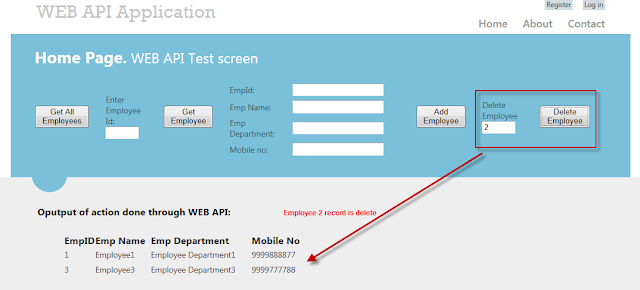In this post we will see how to create a our own WEB API service and will consume it in client using JQuery.
This is the UI i am planning to create, which in-turn talk to a ASP.NET WEB API Service for rendering data. We need to create a API Service and an Application consuming it.

Lets do it step by step.
Step 1: Create a solution and add 2 MVC 4 projects , one with WEB API template and another with INTERNET Application template.

Step 2: Lets create our custom WEB API Service. Go to API_SVC project and under Controllers folder you can see ValuesController.cs. This is the default WEB API service fie added, either you can modify, or you can add a new API Controller, using Add option.

Step 3:I created a Service file with name "EmployeeAPI".
EmployeeAPIConstroller.cs
namespace API_SVC.Controllers
{
public class EmployeeAPIController : ApiController
{
private List<employee> EmpList = new List<employee>();
public EmployeeAPIController()
{
EmpList.Add(new Employee(1, "Employee1", "Employee Department1", 9999888877));
EmpList.Add(new Employee(2, "Employee2", "Employee Department2", 7777888899));
EmpList.Add(new Employee(3, "Employee3", "Employee Department3", 9999777788));
}
public IEnumerable<Employee> GetEmployees()
{
return EmpList;
}
public Employee GetEmployee(int id)
{
return EmpList.Find(e => e.ID == id);
}
public IEnumerable<Employee> Post(Employee value)
{
EmpList.Add(value);
return EmpList;
}
public void Put(int id, string value)
{
}
public IEnumerable<Employee> Delete(int id)
{
EmpList.Remove(EmpList.Find(E => E.ID == id));
return EmpList;
}
}
}</employee></employee>
Step 4:I ensure that it is hosted on IIS and can be accessed through URL mentioned on each of the service methods. for example lets check GetEmployee() method using Fiddler.
Action:

Result:

Now that we confirm that we are done with creation of simple WEB API HTTP Service.
Step 5: Move to the second application i.e., API_APP , the MVC 4 internet application, and open Index.cshtml under Home. To demonstrate the simplicity of ASP.NET WEB API Service, i will call them using nothing but JQuery i.e., Client side code.
Index.cshtml Code View:
@{
ViewBag.Title = "Home Page";
}
@section featured {
<section class="featured">
<div class="content-wrapper">
<hgroup class="title">
<h1>@ViewBag.Title.</h1>
<h2>@ViewBag.Message</h2>
</hgroup>
<div>
<table><tr>
<td><button onclick="GetAllEmployees();return false;">Get All Employees</button></td>
<td>Enter Employee Id: <input type="text" id="txtEmpid" style="width:50PX"/></td>
<td><button onclick="GetEmployee();return false;">Get Employee</button></td>
<td>
<table>
<tr><td>EmpId:</td><td><input type="text" id="txtaddEmpid" /></td></tr>
<tr> <td>Emp Name:</td><td><input type="text" id="txtaddEmpName" /></td></tr>
<tr> <td>Emp Department:</td><td><input type="text" id="txtaddEmpDep" /></td></tr>
<tr><td>Mobile no:</td><td><input type="text" id="txtaddEmpMob" /></td></tr>
</table>
</td>
<td><button onclick="AddEmployee();return false;">Add Employee</button></td>
<td>Delete Employee <input type="text" id="txtdelEmpId" style="width:50PX"/></td>
<td><button onclick="DeleteEmployee(); return false;">Delete Employee</button></td>
</tr></table>
</div>
</div>
</section>
}
<h3>Oputput of action done through WEB API:</h3>
<ol class="round">
<li>
<div id="divResult"></div>
</li>
</ol>
Index.cshtml UI view

Step 6: Lets see how we can associate each button to an action of API Service. First look at "Get All Employees" button and its onclick event in above code.Its is calling "GetAllEmployees()" , a script function in-turn calling WEB API Service using JQuery.
function GetAllEmployees() {
jQuery.support.cors = true;
$.ajax({
url: 'http://localhost:8080/API_SVC/api/EmployeeAPI',
type: 'GET',
dataType: 'json',
success: function (data) {
WriteResponse(data);
},
error: function (x, y, z) {
alert(x + '\n' + y + '\n' + z);
}
});
}
Spare sometime looking at above code snippet. See the URL part of Ajax Get request, that is all we need to consume the WEB API Service we created earlier. Make sure you give all the parameters properly so that it invoke right methods.
Step 7: WriteResponse() and ShowEmployee() are the 2 methods i created to display the JSON result in a proper way. Below is the JQuery part associating each button to a method of WEB API Service.
<script type="text/javascript">
function GetAllEmployees() {
jQuery.support.cors = true;
$.ajax({
url: 'http://localhost:8080/API_SVC/api/EmployeeAPI',
type: 'GET',
dataType: 'json',
success: function (data) {
WriteResponse(data);
},
error: function (x, y, z) {
alert(x + '\n' + y + '\n' + z);
}
});
}
function AddEmployee() {
jQuery.support.cors = true;
var employee = {
ID: $('#txtaddEmpid').val(),
EmpName: $('#txtaddEmpName').val(),
EmpDepartment: $('#txtaddEmpDep').val(),
EmpMobile: $('#txtaddEmpMob').val()
};
$.ajax({
url: 'http://localhost:8080/API_SVC/api/EmployeeAPI',
type: 'POST',
data:JSON.stringify(employee),
contentType: "application/json;charset=utf-8",
success: function (data) {
WriteResponse(data);
},
error: function (x, y, z) {
alert(x + '\n' + y + '\n' + z);
}
});
}
function DeleteEmployee() {
jQuery.support.cors = true;
var id = $('#txtdelEmpId').val()
$.ajax({
url: 'http://localhost:8080/API_SVC/api/EmployeeAPI/'+id,
type: 'DELETE',
contentType: "application/json;charset=utf-8",
success: function (data) {
WriteResponse(data);
},
error: function (x, y, z) {
alert(x + '\n' + y + '\n' + z);
}
});
}
function WriteResponse(employees) {
var strResult = "<table><th>EmpID</th><th>Emp Name</th><th>Emp Department</th><th>Mobile No</th>";
$.each(employees, function (index, employee) {
strResult += "<tr><td>" + employee.ID + "</td><td> " + employee.EmpName + "</td><td>" + employee.EmpDepartment + "</td><td>" + employee.EmpMobile + "</td></tr>";
});
strResult += "</table>";
$("#divResult").html(strResult);
}
function ShowEmployee(employee) {
if (employee != null) {
var strResult = "<table><th>EmpID</th><th>Emp Name</th><th>Emp Department</th><th>Mobile No</th>";
strResult += "<tr><td>" + employee.ID + "</td><td> " + employee.EmpName + "</td><td>" + employee.EmpDepartment + "</td><td>" + employee.EmpMobile + "</td></tr>";
strResult += "</table>";
$("#divResult").html(strResult);
}
else {
$("#divResult").html("No Results To Display");
}
}
function GetEmployee() {
jQuery.support.cors = true;
var id = $('#txtEmpid').val();
$.ajax({
url: 'http://localhost:8080/API_SVC/api/EmployeeAPI/'+id,
type: 'GET',
dataType: 'json',
success: function (data) {
ShowEmployee(data);
},
error: function (x, y, z) {
alert(x + '\n' + y + '\n' + z);
}
});
}
</script>
Step 8: What else we left with except verifying the output.
Action 1:

Action 2:

Action 3:

Action 4:

Step 9: Apart from fact that it is simple to configure and create, we need to consider that its a RESTful service which is light weight and will have incredible performance.
Look at the below snapshot of HttpWatch Log for Action #1, which was completed in 50 milli seconds. I accept both applications are on same machine and solution, but the communication never happened through dlls. The execution happened via IIS just like typical service call. Even if you add the Network lag, we should say it is a good performance.

With this we have seen how to create and consume our own ASP.NET WEB API Service, even with out adding a single line of Server code on client application. Can any service configuration be simpler than this? Is it helpful for you? Kindly let me know your comments / Questions.
